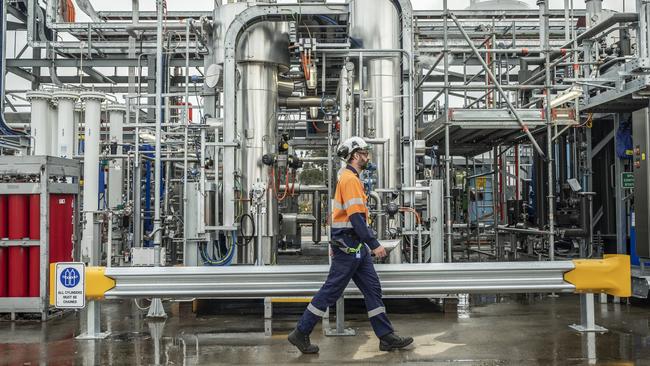Japan’s green energy fund commits $2.35bn to Gippsland hydrogen project
Japan will tip in $2.35bn for a bold plan to make Victoria’s Gippsland region the centre of the world’s first liquefied hydrogen supply chain.

The Japanese government will tip in $2.35 billion towards a clean hydrogen gas project designed to make Victoria’s Gippsland region the centre of the world’s first liquefied hydrogen supply chain.
Some of Japan’s largest industrial conglomerates are spearheading the Hydrogen Energy Supply Chain project, which aims to convert brown coal from AGL’s Loy Yang mine into hydrogen, which would then be liquefied and shipped to Japan.
Carbon Capture and Storage technology would be used to store the carbon emissions in depleted oil and gas reservoirs beneath Bass Strait.
The funding from Japan’s Green Innovation Fund comes as the project enters a commercial demonstration phase following a pilot project last year that delivered liquid hydrogen to the Port of Kobe in Japan.
As part of the funding deal, a joint venture between one of Japan’s largest utility companies, J-Power, and trading house Sumitomo Corporation has been selected to produce the hydrogen via coal gasification.
Kawasaki Heavy Industries and Iwatani Corporation are part of the Japan Suiso Energy (JSE) consortium that will oversee the liquefaction, loading and transportation process.
J-Power Latrobe Valley non-executive director Jeremy Stone said the first hydrogen production was on track to commence in the late 2020s, pending commercial agreements and environmental permits and approvals.
He said 30,000 to 40,000 tonnes of gaseous clean hydrogen would initially be produced each year, ramping up to 225,000 tonnes.
That would reduce carbon emissions by about 1.8 million tonnes a year - the equivalent of about 350,000 petrol cars.
“We are excited to be one step closer to making commercial scale hydrogen production in Victoria a reality,” he said.
“This is a major milestone and a recognition of Gippsland’s unique ability to help reduce global CO2 emissions through the reliable production of large quantities of cost competitive and clean hydrogen.
“Beyond the abundance of natural resources, the area has unrivalled access to a skilled workforce, major energy infrastructure and viable long-term storage for captured CO2 in the Bass Strait.”
Mr Stone said he was expecting further offtake agreements for the hydrogen, which can be used in industrial processes including ammonia, fertiliser and methanol production.
HESC is backed by the state and federal governments, which have previously contributed $100 million to the $500 million pilot project.
The latest injection of capital will enable the Kawasaki consortium to design and build a liquefaction plant, and build other infrastructure required to support the loading of hydrogen onto ships at the Port of Hastings.
The hydrogen plant and terminal are expected to create 1000 ongoing jobs.
Mining and Energy Union Victorian president Trevor Williams said the project would create opportunities for families in the Latrobe Valley, where coal-fired power station closures had created “deep anxiety for the region’s future”.
“Expanding and commercialising this project helps the Japanese economy’s energy transition, while also building a viable new industry to support the economic transition of the Latrobe Valley,” he said.
“We expect that contracts to provide coal to the hydrogen plant will provide full-time, well-paid career pathways for Latrobe Valley coal mineworkers and energy workers facing displacement by power station closures.”
Mr Williams said the hydrogen plant could also open a pathway for producing other carbon-neutral products from Latrobe Valley coal, including urea, ammonia and Adblue.
JSE chief executive Eiichi Harada described the funding deal as a “watershed moment” for the project.
“This commitment of $2.35 billion gives all participants in the hydrogen supply chain the confidence to progress to the next stage of commercialisation,” he said.
“This is a complex project and there is still some way to go in terms of approvals, design, construction and commissioning but this is a major boost for the Victorian economy on its journey towards a clean energy future.”



To join the conversation, please log in. Don't have an account? Register
Join the conversation, you are commenting as Logout